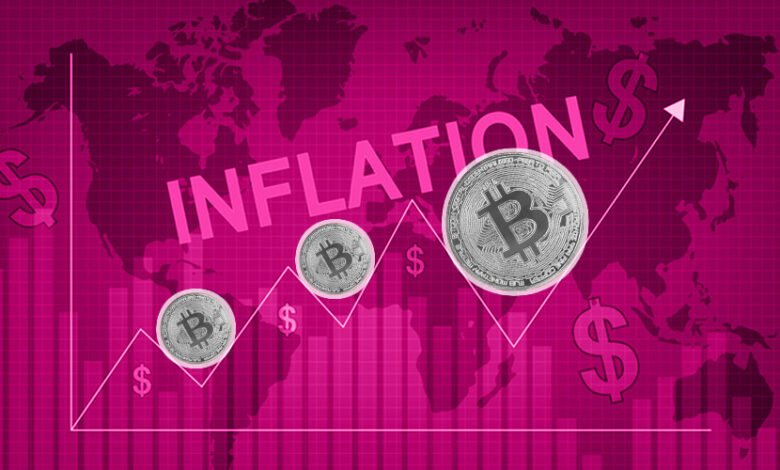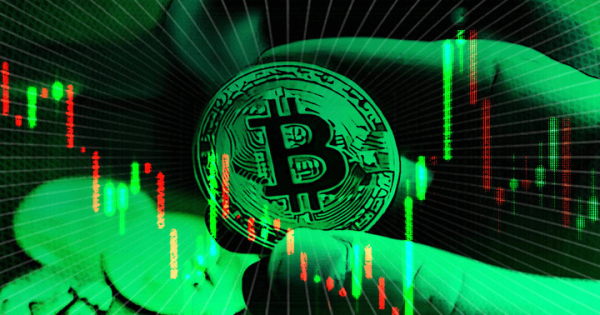Better than anticipated Inflation in the United States should have boosted Bitcoin.

The better-than-expected drop in US inflation figures for October temporarily changed the course of the cryptocurrency markets. Everything appeared to be going well and positively; Bitcoin increased by around 4%, and Ethereum and other cryptocurrencies also rose on the day when inflation data was released. But on Friday, everything suddenly altered since cryptocurrencies are presently experiencing a massacre. Wall Street had its greatest week since the summer by adding further gains to the massive bounce from the day before.
The largest cryptocurrency, Bitcoin, has lost its $17,000 milestone. Past patterns indicated a relationship between Bitcoin’s performance and US inflation statistics up to this point in the year. The most recent US consumer price index reading should have increased the value of Bitcoin, but that is not the case. Why? The FTX cryptocurrency exchange is the reply. After soaring 5.5% for its best day in more than two years, the S&P 500 increased by 0.9% the following day. The Nasdaq composite increased 1.9%, while the Dow Jones Industrial Average gained 32 points, adding to its gain of more than 1,200 points from the previous day.
The US released its consumer price index inflation figures for October on Thursday. The rate of US inflation has decreased for a fourth month, to 7.7%, the lowest level since January of this year. Even better than anticipated is the most recent downturn. The US consumer price index increased by 9.1% in June, which was the highest increase in 40 years. The day that the inflation data were released, Bitcoin grew in popularity to the point where it even crossed the $18,000 threshold. Anurag Agrawal, Principal, Investment Strategy at Kunji, claims that in the past, during periods of high inflation, a rise in the CPI from one month to the next resulted in a collapse of the cryptocurrency markets.
According to Kunji’s data, Bitcoin performed better when inflation increased to 9.1% in June, which was higher than anticipated and more than a 40-year high. The same thing happened in July when inflation slowed more than predicted to 8.5% and Bitcoin increased. When inflation in October came in lower than anticipated, a similar pattern was observed in Bitcoin. According to the data, in October inflation was predicted to be around 8% but instead was 7.7%, a much better slowdown of 30 basis points from street expectations. According to a Kunji expert, markets have recently displayed bullish movement whenever the actual rate has been less than or equal to the expectation, and vice versa.
Equities (S&P), Energy (SPN), and Bitcoin (BTC) all displayed strong correlations, but Gold continued to deviate from the general trend. For Wall Street, the Fed’s decision on interest rates is crucial because increases slow the economy and increase the risk of a recession while also depressing stock prices. They have been primarily responsible for the markets’ difficulties this year.
After China eased some of its stringent anti-COVID regulations that were harming the second-largest economy in the world, markets saw an increase. Stock prices and oil prices both rose as a result of expectations for stronger Chinese growth; U.S. crude rose 2.9% to $88.96 per barrel. The news on Thursday that showed US inflation slowed more than anticipated last month was the key factor for this week’s market optimism.
Though analysts warned that high inflation could be slow to fall, and some sparked expectations that the worst of the inflation may have passed and that the Federal Reserve may be less aggressive about raising interest rates to keep it under control after Wall Street’s significant rise, which was termed excessive.
The Fed has stated that one of the reasons it has moved so quickly with rate rises is to avoid such a doom cycle. According to historical standards, inflation expectations are now high, but a preliminary assessment released on Friday suggested that they are not changing much. A University of Michigan study found that respondents’ median expectations for inflation in the following year rose from 5% to 5.1% from one month earlier.
Meanwhile, long-term inflation expectations increased slightly to 3%. However, that still places them in the same 2.9% to 3.1% range as they have for 15 of the previous 16 months.
He stated: “The two-month CPI data was higher than anticipated. BTC had a sell-off on the day of the September report, along with the S&P 500 and Nasdaq, as investors readied themselves for an aggressive FOMC report. In addition, Agarwal underlined that despite Bitcoin’s October low of $18,300, it increased by roughly 4% as a result of the publication of the CPI. Given that the CPI was higher than expected, this was strange.
He asserted that the fact that BTC is now acting differently on a lot more important occasions than it did last year “shows the relative decoupling and minor bullish trend for the crypto sector.” It may matter just as much how awful inflation is today as how high U.S. people expect it to be in the future. That’s because people may speed up purchases and take other actions that fuel inflation, creating a vicious cycle when expectations are too high.
On CoinMarketCap, Bitcoin declined on Friday, reaching a 24-hour low of $16,543.48. It is currently trading below $16,800 and down about 5%. Also down 4%, ether is now worth less than $1,260. BNB, the native token of Binance, lost over 6.5% and is currently trading around $285. In the past day, rivals like XRP fell more than 3%, Cardano lost nearly 6%, and Dogecoin lost nearly 7%.
Due to the recent severe selloff, Ether has dropped by more than 22%, Bitcoin has dropped by roughly 19% weekly, and BNB has dropped by almost 19%. The market value of all cryptocurrencies is $850.33 billion on CoinMarketCap, which is down by close to 5%. The panic in the cryptocurrency markets is being caused by the bankruptcy announcement of the crypto exchange FTX.
The survey’s rating for overall consumer mood was significantly lower than experts had anticipated because of high inflation. According to Brian Price, head of investment management at Commonwealth Financial Network, “the consumer is laser-focused on inflation and they are feeling it every day.” “Until inflation is under control, I wouldn’t anticipate seeing much improvement in consumer mood.”
The Federal Reserve previously increased its benchmark overnight interest rate from almost zero in March to a range of 3.75% to 4%. The most likely scenario is that rates will continue to rise until the end of the year and then be held there for a while. Markets are hoping that a slowing of inflation will lead to the Fed holding interest rates steady at a lower, less painful level for investors than it otherwise would have. All along, they had made it very obvious that they would front-load interest rate rises, according to Price. “Over the coming months, they will need some time to analyze the data.”
According to CME Group, traders are increasingly betting that the federal funds rate will peak in the range of 4.75% to 5% by the beginning of next year. They believed a higher final rate was more likely a week ago, with a sizable portion anticipating somewhere between 5.25% and 5.50%. Veterans Day trading on the bond markets was suspended. As investors reduced their expectations for how quickly the Fed will hike rates, yields fell on Thursday.
Anurag remarked, “The CPI number coming in at 7.7%, well below the expected 8.0%, gave markets a little relief on the evening of November 10th, despite the US midterm elections being favorable for most markets, except cryptocurrency. Although the gain in BTC, ETH, and other cryptocurrencies appears to be greater than that in stocks, it is only a very temporary phenomenon. The true effects of the crypto contagion brought on by FTX’s bankruptcy have not yet been determined.”
A message was posted on FTX’s Twitter account. It was announced that FTX Trading, West Realm Shires Services (FTX US), Alameda Research, and roughly 130 additional affiliated companies (collectively, the FTX Group) have initiated voluntary proceedings under chapter 11 of the United States Bankruptcy Code in the District of Delaware to begin an orderly process to review and monetize assets for the benefit of all global stakeholders. Sam Bankman-Fried has also given notice of his resignation as the FTX Group’s CEO. John Ray III has been chosen to assume the role of CEO.
In addition, many FTX Group workers in several countries are anticipated to stay with the FTX Group and support Ray and independent specialists in operations during the Chapter II procedures,” the company added in its statement. Ledger LLC, FTX Digital Markets, FTX Australia, and FTX Express Pay are FTX Group entities that are not involved in the Chapter 11 proceedings. It seems familiar. A scenario like FTX is not new to the cryptocurrency markets. Leading cryptocurrency exchanges Celsius and Voyager Digital are undergoing insolvency proceedings, just like FTX.
FTT, the sister token of FTX, has dropped by 50% at its worst in just one day, which is enough to bring to mind the May flash crash of Terra sister tokens USD and LUNA. Impact investors are likely to turn to cryptocurrencies in response to the FTX crisis. Wealth worth billions of dollars is under threat in this market. The FTX-backed token FTT is currently trading at around $2.7, down more than 23.5%. The market capitalization of FTT has lost millions of dollars and is currently close to $363.58 million. On CoinMarketCap, it has decreased more than 89% weekly and over 88% monthly.
In Aggarwal’s opinion, FTX’s decline will undoubtedly wreak havoc for crypto markets in the upcoming months because it is one of the most linked enterprises throughout the Trading ecosystem, private crypto equity, sports stadiums, and other venues. Even though a final leg up is highly likely for the overall markets, he continued, “after this episode, structural changes in the crypto ecosystem and much stricter regulations should be expected.” FTX, founded in 2019, has its main office in The Bahamas. The exchange had over a million users as of February 2022.
Edited by Prakriti Arora




